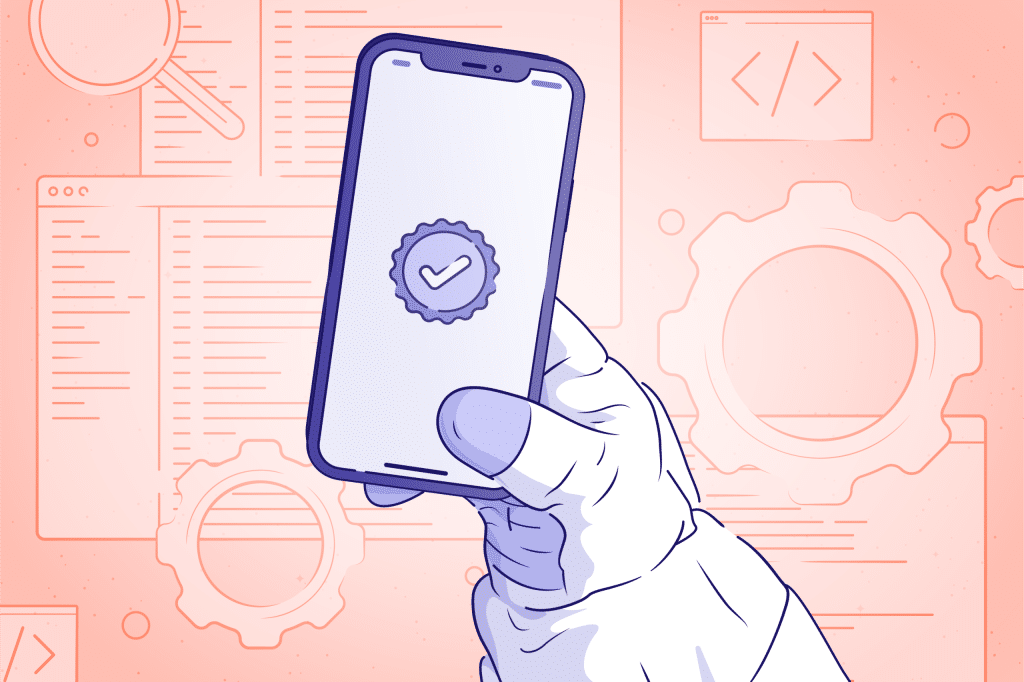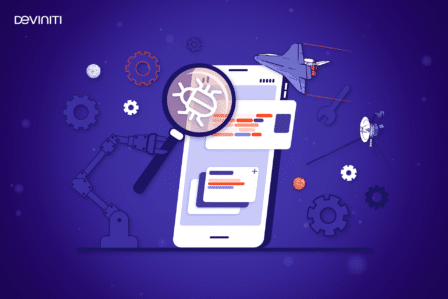Step-by-step mobile application development

Mobile applications have become part of our everyday life. As data shows, users of mobile devices generate over 60% of Internet traffic. How can companies ensure the highest quality of the mobile application and deliver a positive user experience? Keep in mind that the software development process is not just about writing an app and listing it in a store. This article will show you how to create a mobile application step by step.
The idea for a mobile application
Coming up with an idea and implementing it from start to finish are rarely one person’s job. Building a mobile application is a complex process that requires the involvement of many people with different skillsets. The work usually starts with the client who comes to us looking for a solution or a way to implement their idea. This stage affects the arrangement of the process and all the activities that come next.
Mobile App Development: Requirements Analysis
Once the first contact with the client is behind us, we carry out a workshop focused on a thorough analysis of the requirements. In the case of mobile applications, it is necessary to determine:
- Are we building an app for iOS, Android, or maybe both systems?
- Do we code it natively or cross-platform?
- Which software versions do we support?
- Do we support the application in landscape mode?
- Are we going to implement a tablet version of the app?
We always conduct comprehensive technical and business analyses. This is how we help the client explore new ideas to create or improve a business. This is also when we start building business relationships. Let’s not forget that the decision to cooperate should be made jointly – not only by us but also by the client.
System architects, analysts, and software developers take part in such workshops. The result should be:
– a proposal of the best technology,
– a specification of the requirements,
– business model design,
– selection of the cooperation model.
Creating a mobile application: design
The client said yes! It’s time to establish the technical requirements. During technical workshops, we conduct a detailed analysis. We reconsider all requirements, prepare mock-ups, and develop documentation to be accepted by both parties. We also estimate all potential project costs, e.g., development accounts (required to place the application in a store), backend environment, etc.
To facilitate communication, the client should designate a contact person: PO (Product Owner) or SPOC (Single Point of Contact), who will be responsible for direct cooperation with our team.
We also carry out a detailed risk analysis and advise on how to minimize project risk. Moreover, we create a project template that includes the project’s scope, risks, and priorities. We also prepare business requirements in the form of user stories, which is very important in the business-developer contact because it allows us to translate business language into technical language and facilitate communication.
Technical workshops last from one day to several weeks and require the involvement of an analyst, developer, project manager, and a customer contact person.
Mobile application development: hosting
One aspect that we need to clarify during the technical workshops is the choice of hosting for the mobile application. Currently, server solutions are on their way out. For this reason, it rarely happens that the customer has to provide new, appropriate infrastructure. We usually use the existing infrastructure (ours or the client’s) or choose cloud solutions. The exceptions are banks that always provide their own hosting infrastructure for security reasons.
Creating a mobile application: solution model
After determining the client’s needs and requirements, we can prepare one of three solutions: MVP, Version 1.0, or Proof of concept (POC).
Mobile applications: MVP
MVP is a working application in its first minimal version. We apply the Pareto principle – the application is functional enough to allow you to run a business. To save time, we propose solutions that aren’t complicated from the developer’s point of view – e.g., by using an external library. This is a good idea when we’re on a tight budget. That way, we can also analyze customer reactions and add additional features on this basis. The MVP may be version 1.0 of the mobile application.
Mobile applications: version 1.0
Version 1.0 is an application version equipped with all predefined functions. It’s a form of a finished product that is already operational, but its development will continue in subsequent versions. This allows the customer to analyze user behavior and adapt the application to their needs.
Mobile applications: Proof of concept
POC is a kind of trial version for a customer. In this model, we create one module or one application function so that the customer can verify our method, quality, and speed of work.
Creating a mobile application: programming
Before starting the development, we need to provide a specific offer, individual components of implementation, determine personnel and server costs, etc. This also includes managing the work of the development team.
If the client requires it (for example, for security reasons), we develop the application in the T&M system. We provide a trained, motivated, and competent team, but the client is directly responsible for work and task management.
Mobile application testing
There’s no need to convince anyone of the importance of software testing. That’s why we don’t leave tests at the end of the project but run them at the end of each sprint and stage. We deliver test applications via TestFlight (iOS), beta/alpha channels on Google Play Store (Android), Firebase Distribution, or Bitrise (both platforms). This allows us to react on a regular basis: make changes, remove defects, fix errors in the code and functions.
After completing the mobile application development process, we hand over the finished project to the client. Depending on the type of project and the contract with the client, they then perform acceptance tests (UAT) and check if the application complies with the documentation and requirements. At the client’s request, we can also make the application available to selected testers on their site.
In order for the application to reach the store, we also need developer accounts, application descriptions, screenshots, links to the privacy policy, etc. When the customer finally accepts the application, it goes to the production environment and from there straight to the end-users.
Ready mobile application: maintenance
We wrote the application, the last line of code was committed, and what’s next? We value lasting business relationships, so our cooperation doesn’t end at the stage of introducing a mobile application to the store. We are also often involved in the further development of the application.
We offer additional paid support as well. The client has access to a dedicated team that, if necessary, can fight the biggest issue and eliminate problems even in the middle of the night.
If you like our approach to creating mobile applications, we invite you to cooperate with us. Contact us and let’s talk about your ideas. If you’d like to learn more, please read other articles on our blog.






